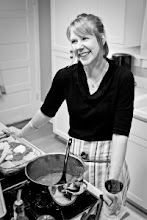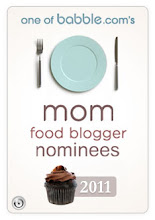
Nerd alert. Not as in quantum physics and mathletes, but the kind of nerd who kind of became a little obsessed with a certain cake recipe. It started by taking a few simple notes. That led a very pleasant conversation with a culinary historian named Sandy Oliver in Maine. And more research flipping through cookbooks on my own shelves, online and even researching product histories.
See, bona fide nerd.
If you want to just see this stinking cake recipe, click here. Otherwise, indulge me, and keep reading.
This whole thing started with Jasper's birthday. When you turn 2, it only seems right to have your mom make you some cupcakes. And, yes, I probably could have gotten away -- guilt-free, even, perhaps -- with a box mix. After all, I'm eight months pregnant, and despite the fact that I cooked for 80 people a month ago, baking for a half-dozen neighbor kids sounded like a lot of work. But, I decided it would be fun to test a couple of recipes, and I had a few events I needed to bake for anyways, so off I went in search of a simple chocolate cake recipe.
It's not that a chocolate cake recipe is a hard thing to track down. Every comprehensive cookbook I own has at least four or five of them. The real trouble is winnowing down the list and picking one to try. I started by reading a bit of "Cookwise" by Shirley O. Corriher where I caught up on the importance of fats helping to aerate a cake.
That's what led me to a Southern Living cake recipe that started with shortening, an excellent fat to start a cake off right given the gas bubbles already nestled inside a stick of vegetable shortening. Well, much to my disappointment, that cake wasn't really that great. The texture wasn't a fine, moist crumb, but a chunky tough one with a crust that made no attempts at hiding its flaws.
Two days after baking that version, I received a magazine in the mail called Cuisine at Home, a publication I'd never heard of but assumed came via my subscriptions to other food magazines. The last two pages were devoted to an Old-Fashioned Chocolate Cake recipe. I read through the recipe and the accompanying text that boasted this as the cake your grandmother made. And not only that, it said the cake was simpler than a box mix. This, I had to try.
It wasn't until I started mixing this cake batter at about 9 o'clock one night last week that I realized I already knew this recipe. I hadn't baked the cake before, but I'd read this recipe. I knew the exact cookbook I'd seen it in, some community cookbook from New Mexico that I'm pretty sure came from a stack of cookbooks from my grandmother's house. It was the very first recipe in that book and was called Crazy Teenage Cake. Seriously, how could I not remember that?
What was odd about it the recipe is that it had no eggs, used vegetable oil for its fat and contained vinegar. Again, how could I not remember that?
As I waited for that cake to bake last week, I thumbed through my bookshelves and found that community cookbook and turned to that recipe. I sat, dragging my index finger through the batter clinging to the side of my mixing bowl and then licking it, again and again (remember, no eggs, even this pregnant woman can indulge in this cake batter) and compared the recipe from the magazine to the one in that book. The only difference is that the recipe from the magazine, which is surely armed with a test-kitchen staff, offered more precise instructions. It also struck me as odd that the cake was vegan, well before that trend caught the bandwagon, at least in this country.
I started poking around and discovered a few things. And to be fair, although I'm a nerd, I'm no historian, but here goes: During World War I, there was a shortage of meats, butter, eggs and lard, so ingenious cooks started coming up with ways to use what they had, including creating cake recipes without these ingredients. This also follows shortly behind the turn-of-the-century trend of baking with cocoa thanks to manufacturers such as Hershey's giving home cooks suggestions on how to use their products. Basic groceries, especially proteins and dairy remained hard to come by through The Depression and the second World War. Recipes like this one likely remained popular for a few decades before it was lost to all but the grandmothers thanks to box cake mixes taking off around the 1940s.
All of this made sense to me, but several searches revealed that versions of this cake are often called wacky or crazy, as in the Crazy Teenage Cake or simply Wacky Cake. It struck me as odd that such a silly name for a cake would stick -- and I'm not just referring to the community cookbooks. My best guess for this is that it has to do with the science behind the cake. It's a basic grade-school memory for most of us. When you combine baking soda and vinegar you get a fun, fizzy reaction that works well if you've built a replica volcano or are looking to power a rocket or vehicle with basic physics. The combination makes millions of gas bubbles that ooze and puff. Yes, fine volcano lava it does make, but it seems that it also does an amazing job of mimicking that aerated texture you might get from butter or shortening that has been whipped in a stand mixer until fluffy. You can even hear the experiment begin when you combine the wet and dry ingredients of this cake. It sounds like the fizz of a soda poured straight from a bottle.
Call it wacky, crazy or old fashioned, this cake is truly simple. It has a moist, fine crumb and true chocolate flavor, and, it really isn't that much harder than a box mix. You could keep it vegan with a simple dusting of powdered sugar, or do as I did and load it with some cream cheese icing. Either way, this is a recipe you won't mind keeping around, either.
The recipe follows in the previous post.





